Am Ghost, I post very occasionally. Call me whatever you want, it's confusing anyway.
Don't wanna be here? Send us removal request.
Photo

#fallen london#Horrifying Confirmation that you were Right All Along#I love the way this is capitalized for aome reason#I guess it kinda feels like a tumblr post#or is it just me
691 notes
·
View notes
Text

Saw some lady at the train station with a long flowing white skirt, walking a dog with a long flowing white fur, and they both were glowing equally in the contre-jour light of sunshine. Had to draw a rough sketch of them and then shittily shade it on my phone so I'll remember to try to draw them later.
8K notes
·
View notes
Text
daily affirmations:
i am kind
i am in control of my emotions
it does not bother me when someone is in the kitchen while i was planning to be in there alone
everyone in the house has the right to be in the kitchen
i am kind and in control of my emotions even when someone is in the kitchen while i was planning to be in there alone
#everyone is allowed to be in the kitchen#it does not bother me that they don't respect the only hour of the day I get to not deal with people
118K notes
·
View notes
Text

huge shout out to this little kid for writing my favorite poem
147K notes
·
View notes
Text

Hi hello! Long time no post. 11 years to be exact! Here’s some stained glass swords I made- the Knights of Summer. I’m working on the Knights of Autumn right now, so if you’re interested, stick around!
1K notes
·
View notes
Text
imagine a goat with a hat
STOP-
what hat did you give the goat what is the instinctual hat you gave to this goat
47K notes
·
View notes
Text
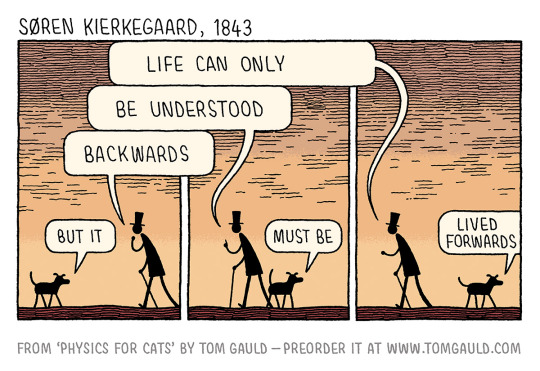
My next book of science cartoons Physics for Cats is available to preorder now! Links here: www.tomgauld.com
7K notes
·
View notes
Text
ill spend my twenties investigating the healing properties of salt i dont know about you guys
118K notes
·
View notes
Text
I saw a fun craft that I want to try that requires paper shopping bags - the video I saw used Trader Joe’s bags, but I don’t have a Trader Joe’s near me so I ran to the Aldi in my neighborhood to pick some up.
Tell me why I’m at the self checkout, counting out 40 bags and looking over my shoulder like some kind of furtive character, because my brain is screaming at me, “They’re going to think you’re in here acting strange, buying just bags, exchanging money for goods like some kind of whackadoo.”
Truly, a 10/10 anxious experience.
184 notes
·
View notes
Text


#i voted pass but#smash (violent)#fallen london#< prev I'm so glad I'm not the only one who immediately thought of “smash (violent)”
16 notes
·
View notes
Text
I know in another post I talked about the irony of living in a capitalistic society when you are a creator, how everyone always tells you to sell what you make. But it’s also such a massive confidence boost sometimes???
Like you can show someone the first row or two of a crochet project and be like “this is how it’s going”. You might feel like complete shit about the project, maybe you’re struggling working with the yarn, you can’t stop seeing all the errors you’ve already made. But the person you showed it to who cannot crochet?
“WHAT YOU MADE THAT? YOU MADE ALL OF THAT? YOU SHOULD SELL THAT OH MY GOD YOURE SO TALENTED”
My favorite part is blowing their minds and telling them “this is just the beginning of the project”. It’s such a sweet thing, it really shows how true it is that often times, you are the only one noticing your minor mistakes as an artist because you’re familiar with your project and the medium you’re using. The average Joe walking around is just bewildered you can take a piece of paper and turn it into another world with words or the strokes of a brush, a ball of string and make it into something they can drape on their shoulders.
13 notes
·
View notes
Text
this little freak keeps sneaking into my garden and rubbing himself all over my flowers??Hello?????
155K notes
·
View notes
Text
i love it when fallen london adds funky new mechanics. go, my agents, go fuck some zailors or whatever. take my silliest hat with you
322 notes
·
View notes
Text
the biggest epistemological gap between me & 95% the rest of the world is literally just how much i love to look things up on the internet and how much it baffles me when other people don't like to do this. we live in the information age. like i'll google anything i'll read this bmj paper on the toilet i'll look up words i don't know i'll append pdf free to any possible phrase. i don't know how anybody is voluntarily turning this down. sometimes i get so tired of searchinf for something physically inside a store i pull out my phone and google like silken tofu aldi what fucking aisle while im standing right there. otherwise what is even the point
#EXACTLY#someone near me will be like “I wonder what this means”#or “I wonder where this comes from”#and I just immediately pull out my phone and look it up#it's so convenient#why do people not do it
21K notes
·
View notes
Text
there's a fine line between being wary of manipulation and becoming completely paranoid because you get very close to the realisation that pretty much all human interaction involves doing things we hope will lead to a result we like
82K notes
·
View notes
Text
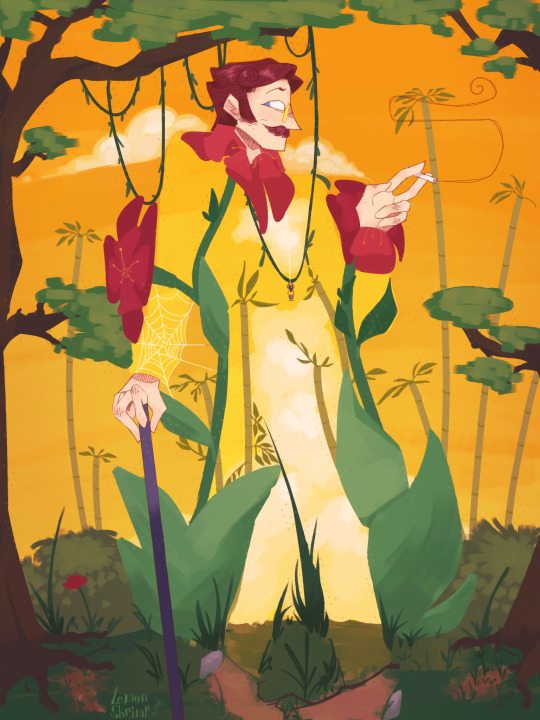
The Parabolan “Invisibility” “Cloak”
It’s not actually a cloak. It makes you invisible, sure, but it also distorts the world around you so that anyone looking at you sees you wearing something anyways, and therefore the visibility is quite high. What it most certainly is, however, is my submission for @neathyfashioncoalition ‘s prompt! After all, what screams Parabolan Elegance more than the landscape itself?
#INCREDIBLE concept#genuinely love this in a way that's hard to describe#fallen london#art#digital art#neathy fashion coalition
342 notes
·
View notes
Text
Fellowship Cloak Weaving Draft
Hi all! I've been kind of quiet on this blog, but I have something really exciting to share today: after six years, I FINALLY figured out the weaving draft for the Fellowship cloaks from Lord of the Rings.
This is a problem I've been trying to figure out since shortly after I made my Legolas cosplay in 2018. The cloaks that the nine members of the Fellowship receive in Lothlórien look like a nondescript gray fabric from far away, but zoom in and you'll see a very complex pattern of horizontal and vertical bars of dark gray and white.
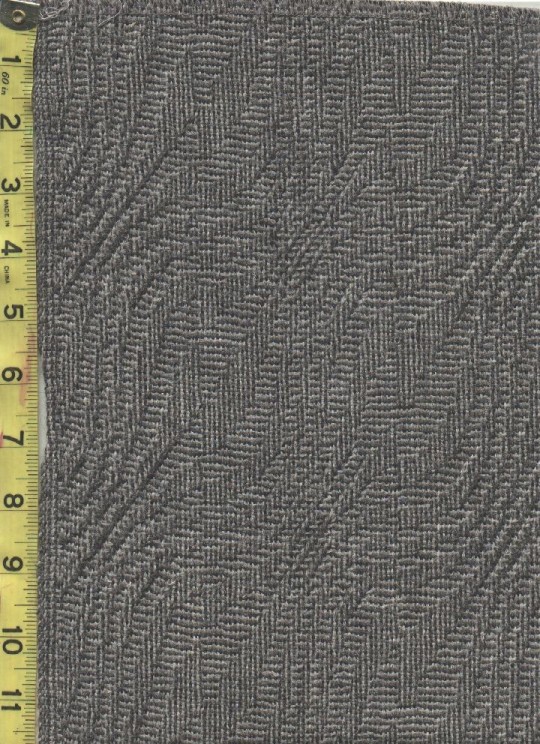
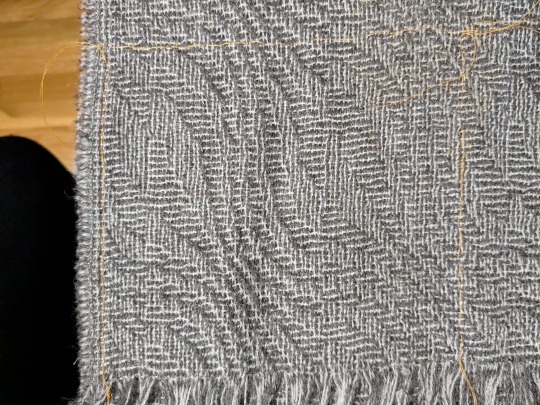
(First image from Alleycatscratch, second is a photo of the scarf of the same fabric I bought from Stansborough where I was attempting to trace the pattern repeat with orange thread)
This is going to be a long post, so I'm just going to lead with the completed draft:

Imagine me Will Smith wife posing at this for the last 24 hours.
It's got the correct size of pattern repeat! It's got the five individual ripples! It's got that dumb little pattern break in the middle that breaks up the center of the leaf motif! I am OVER THE MOON about figuring this out, especially starting out with very little knowledge about weaving drafts in general. More ramblings about this type of draft and my thought process below:
This particular pattern is known as "shadow weave," a subset of color-and-weave where the pattern is created from the interplay of different warp and weft colors plus the weaving draft itself. To get an idea of how that works, let's start by looking at plain weave in one color:

The solid purple bar at the top indicates the color of the warp threads, and the solid purple bar at the right indicates the color of the weft threads. So far we've got our basic under-over-under-over pattern in a single, solid color (purple). But what if we add an additional color (green) to the warp, and alternate those colors? Then we'd get a speckled fabric like this:

The visual effect looks pretty much identical regardless of if you start with green or purple. However, if you also alternate purple and green in the weft, it produces a very different effect depending on if you start with purple or green (note the differences in the bar on the right):


So cool, now we can make either vertical or horizontal stripes! If you double up on the colored threads in some areas, you can even flip between the two and start dividing the fabric into "blocks," like so:


Note that with all these changes, the only thing we've been doing is changing the order of the colors in the warp and weft. The actual weave structure itself is still just regular ol' plain weave. The pattern that we've created in the pictures above is called "log cabin," which you can read about here. But similar effects can be created by skipping shafts/picks in the weaving draft as well. So how do we get from log cabin into the more complicated and general category of shadow weave?
It's weird to describe how to convert a given pattern into shadow weave. There are multiple very good books with chapters on shadow weave as well as books entirely dedicated to it. Despite my best efforts, all these explanations still got so technical so fast it feels like, to me at least, asking a 6 year old to recite an entire Shakespeare play verbatim immediately after confirming that they can, in fact, sing the alphabet song. So I'm going to give my best shot at explaining it, and if it doesn't make sense, just blame it on me and check out some of the linked books above if you're really curious.
Think of shadow weave as a beauty filter for a black and white drawing. If you create a pattern out of black and white blocks/pixels/whatever, the shadow weave "filter" can be applied to it to create a similar pattern that preserves the shapes in the original, but makes them out of vertical/horizontal lines instead of solid color blocks. So in some of these books you'll find mention of converting a twill or an overshot pattern into shadow weave - that's what this is referencing. The original pattern (usually designated with light yarn) gets a secondary shadow pattern (in dark yarn) inserted into in between every other thread (also called an "end" when referencing warp yarns).
I got stuck at this point for literal years. I could find examples of weaving drafts using shadow weave, but couldn't figure out how to generate ones of my own. I imported some of the drafts I found in books into weaving software and poked around to see if I could push the patterns in the direction I wanted by changing individual elements. My experiments in changing individual warp ends and weft picks always ended up looking like stretched or compressed versions of the original pattern (when I was being careful), or incomprehensible garbage (when I was being daring). I even bought a sample of the fabric from Stansborough in the form of a scarf, thinking I could brute force it by using a magnifying glass to figure out the interlacements. I was able to figure out how large the pattern repeat was (approximately 160 x 80 ends), but otherwise I got nothing but eye strain. I ended up tabling the project and coming back to it every couple years, banging my head against it until I gave up.
Until one day last week when I was flipping through the Strickler book and saw this page:

And I was like

HOLD UP
IT'S HER


...or at least a close cousin of her. BUT IT WAS A START.
So the first step was to identify what about this pattern needed to change in order to make this look like the Fellowship cloak. Overall, the main differences were:
Pattern repeat on Strickler 304 was too small - it was 42 x 42 ends and I needed it to be somewhere in the ballpark of 80 x 80 before altering the repeat.
The Fellowship pattern has a weird vertical dividing line that runs down the middle of the leaf motif, effectively doubling the width of the repeat by creating two similar looking but different leaves. This was the change I was least concerned about, as flipping between vertical and horizontal lines is pretty a straightforward process as shown above with the log cabin draft.
Strickler 304 also has a different number of waves (peaks and valleys, or whatever you want to call them) compared to the Fellowship pattern. There are 3 waves in Strickler and 5 in Fellowship. Figuring out how to add these extra waves was the biggest obstacle for me to address.
And finally, a couple of things I didn't need to care about for the weaving draft: 1) the Fellowship pattern is elongated in the warp direction, but this has more to do with a little extra spacing between weft picks as compared to the warp threads. When weaving this you'd just need to make sure you don't beat it very hard and you'll get that tall rectangle shape instead of a square repeat. 2) Both patterns have mirrored symmetry around a diagonal line drawn through the center, meaning that for treadling I could "tromp as writ" or basically just mirror the threading diagram to get the treadling instructions. For reasons I can't figure out, the Strickler pattern isn't exactly tromp as writ but looks close enough to it that the effect is still there. But I don't really care enough to figure out why - the important thing is that it gives us a threading diagram to start with!
So to start with, here's what Strickler 304 looks like in my weaving software:

(By the way, this is Fiberworks PCW Bronze. The trial version is free, and the only difference between that and the paid version is that the save/print options are disabled. I'm not sure they know about screenshots, bless their hearts.)
This is a design for 8 shafts and 8 treadles, thus the 8x8 square in the upper right corner. And you can see in the threading diagram (upper horizontal bar) and treadling diagram (right bar) that the curvature of the waves takes a similar shape to the curves of the final pattern. We just have to figure out why. And since I had already tried changing individual warp ends and treadling patterns without much success, I needed to approach in a different way.
What ended up helping me see the forest for the trees was de-shadowifying the pattern. It's relatively easy to get the black-and-white version of the pattern from the threading draft - you just need to delete the shadow, which means removing every other warp end. This is what deleting all the dark ends from the warp and light ends from the weft looks like:

We can also see with a little more detail how the threading diagram is similar to the curve in the pattern. The pattern is 21 pixels tall, but it's been chopped up to repeat over 8 shafts, like so:

OKAY COOL COOL COOL. EVERYTHING'S COMIN' UP MILHOUSE IVORIVET. From this green squiggly line we know two things:
The final number of warp ends in the shadow weave pattern is double whatever the height of the squiggle is. In the case of the Strickler pattern, we're going from 21 to 42. Since we know that we need our final height for the Fellowship pattern needs to be 80, the squiggle for that pattern needs to be around 40 pixels tall.
We needed to stitch three repeats of the Strickler threading diagram together in order to see the full squiggle. How many waves does the Strickler pattern have? Three. How many waves does the Fellowship pattern need? Five. How many shafts do we have to work on? Eight. What is 5 x 8? 40!!!
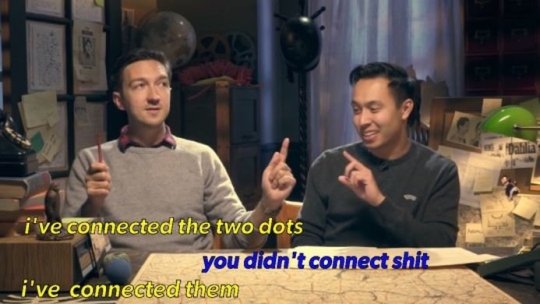
So how about we make a NEW squiggle, only 40 pixels high instead of 21? (We're gonna drop the pixels in blue, since threading diagrams won't work if you put a single end through two shafts.)


Next, we're going to chop up that squiggle and use it to create a new threading diagram in Fiberworks. I'm also using "tromp as writ" here to create the treadling pattern.

LOOK AT THAT. IT'S GOT MORE WAVES!! FIVE OF THEM!
And then we add back in the shadow by creating a space for a new end between each existing end:


And then add in the shadow. I'm using 4 as my number for the shadow offset since we're using 8 shafts. So shaft 1 shadows to shaft 5, shaft 2 shadows to shaft 6, etc.

And we're going to apply tromp as writ again to get:

AYYYYYY WE'RE GETTING CLOSE! I'm fairly certain that the reason why the Strickler treadling wasn't exactly tromp as writ had something to do with centering the pattern repeat a little more than this, but I don't really care about that so I'm going to leave this treadling the way that it is.
From here out, we need at add that weird vertical dividing line that chops up the center of the leaves. So we double the pattern repeat along the horizontal axis, and offset a 40 pixel section in the middle of the threading diagram by 1 pixel. I've also colored in the differences between the dark and light ends to help differentiate the original and shadowed curves a little bit more. (I also tried offsetting the colors of the warp ends by 1 as well like what we did in the log cabin example, but I ended up liking the way that this looked more.)

THERE SHE IS!!! MY PRECIOUS!!

From here on out, there is still a ton of work I need to do if I actually want to weave this cloak from scratch. I did buy roving in quantities that could be used to spin both the dark and light yarn (dark gray Gotland for the dark yarn, and dove gray merino + white alpaca for the light yarn), but there's still the matter of, like, handspinning a cloak's quantity of extremely fine yarn. I did start spinning the Gotland several years ago as fine as I could possibly manage, and got through maybe 20 ounces of it. However, I'm a much better spinner now and I'm not sure if the my skeins from several years ago would be suitable for weaving, or if it would be worth replicating what I did back then vs. just starting over with a new standard. There's also the possibility of just... buying weaving yarn if I want to skip that step, which would definitely save me a significant amount of time.
Anyway, thanks for reading this far and I hope it helped break down why this was so exciting for me!
904 notes
·
View notes